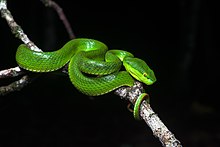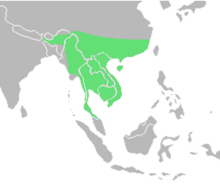Trimeresurus albolabris, the white-lipped pit viper or white-lipped tree viper, is a venomous pit viper species endemic to Southeast Asia.
| Trimeresurus albolabris | |
|---|---|

| |
| Scientific classification | |
| Domain: | Eukaryota |
| Kingdom: | Animalia |
| Phylum: | Chordata |
| Class: | Reptilia |
| Order: | Squamata |
| Suborder: | Serpentes |
| Family: | Viperidae |
| Genus: | Trimeresurus |
| Species: | T. albolabris
|
| Binomial name | |
| Trimeresurus albolabris Gray, 1842
| |

| |
| Synonyms | |
| |
Taxonomy
editGiannasi et al. (2001) raised insularis and septentrionalis to species level.[4][5] Malhotra & Thorpe (2004) transferred this species (and a number of others) to the genus Cryptelytrops.[6] David et al. (2011) returned it to the genus Trimeresurus and assigned it the subgenus Trimeresurus, creating the new combination Trimeresurus (Trimeresurus) albolabris.[3]
Common names include green tree pit viper, white-lipped pit viper,[4] white-lipped tree viper, white-lipped green pit viper and white-lipped bamboo pit viper.[7]
Description
editMaximum total length males 600 mm (24 in), females 810 mm (32 in); maximum tail length males 120 mm (4.7 in), females 130 mm (5.1 in).[8]
-
T. albolabris, White-lipped pit viper (adult, male) – Kaeng Krachan National Park
-
T. albolabris, White-lipped pit viper (adult, female) – Kaeng Krachan National Park
-
T. albolabris (juvenile/male) – Kaeng Krachan National Park
-
T. albolabris (juvenile/female) – Kaeng Krachan National Park
-
T. albolabris at the Houston Zoo
Head scalation consists of 10–11(12) upper labials, the first partially or completely fused to the nasal. Head scales small, subequal, feebly imbricate, smooth or weakly keeled. The supraoculars are narrow (occasionally enlarged and undivided) with 8–12 interocular scales between them. Temporal scales smooth.[8]
Midbody has 29 (rarely 19) longitudinal dorsal scale rows. The ventral scales are 155–166 in males, 152–176 in females. The subcaudals are paired, 60–72 in males, 49–66 in females. The hemipenes are without spines.[8]
Color pattern: green above, the side of the head below the eyes is yellow, white or pale green, much lighter than rest of head. The belly is green, yellowish or white below. A light ventrolateral stripe is present in all males, but absent in females. The end of tail is not mottled brown.[8]
Distribution and habitat
editFound in Nepal, northeastern India (Assam and Jharkhand), Bangladesh, Myanmar, Thailand, Cambodia, Laos, Vietnam, southern China (Fujian, Hainan, Guangxi, Guangdong), Hong Kong, Macau, Indonesia (Sumatra, Java, Lombok, Sumbawa, Komodo, Flores, Sumba, Roti, Kisar, Wetar). The type locality given is "China".[2]
Diet
editIts meals consist of birds, small frogs, and small mammals. This snake doesn't strike and release its prey; like many arboreal snakes, rather holds on to the prey item until it dies.
Venom
editThe venom is primarily hemotoxic. Results of bites from this species range from mild envenoming to death. The venom of white-lipped pitviper contains procoagulant properties. There have been numerous reported bites with few fatalities.[9]
References
edit- ^ Stuart, B.; Thy, N.; Nguyen, T.Q.; Auliya, M. (2012). "Cryptelytrops albolabris". IUCN Red List of Threatened Species. 2012: e.T178433A1534017. doi:10.2305/IUCN.UK.2012-1.RLTS.T178433A1534017.en. Retrieved 28 November 2021.
- ^ a b McDiarmid RW, Campbell JA, Touré T. 1999. Snake Species of the World: A Taxonomic and Geographic Reference, Volume 1. Herpetologists' League. 511 pp. ISBN 1-893777-00-6 (series). ISBN 1-893777-01-4 (volume).
- ^ a b Trimeresurus albolabris at the Reptarium.cz Reptile Database
- ^ a b Gumprecht A, Tillack F, Orlov NL, Captain A, Ryabov S. 2004. Asian Pitvipers. GeitjeBooks Berlin. 1st Edition. 368 pp. ISBN 3-937975-00-4.
- ^ Giannasi, Nicholas; Thorpe, Roger S.; Malhotra, Anita (2001). "The use of amplified fragment length polymorphism in determining species trees at fine taxonomic levels: analysis of a medically important snake, Trimeresurus albolabris". Molecular Ecology. 10 (2): 419–426. doi:10.1046/j.1365-294x.2001.01220.x. PMID 11298956. S2CID 18069035.
- ^ Malhotra, Anita & Thorpe, Roger S. (2004). "A phylogeny of four mitochondrial gene regions suggests a revised taxonomy for Asian pitvipers (Trimeresurus and Ovophis)". Molecular Phylogenetics and Evolution. 32 (1): 83–100. doi:10.1016/j.ympev.2004.02.008. PMID 15186799.
- ^ U.S. Navy. 1991. Poisonous Snakes of the World. US Govt. New York: Dover Publications Inc. 203 pp. ISBN 0-486-26629-X.
- ^ a b c d Leviton, A.E.; Wogan, G.O.U.; Koo, M.S.; Zug, G.R.; Lucas, R.S. & Vindum, J.V. (2003). "The dangerously venomous snakes of Myanmar. Illustrated checklist with keys" (PDF). Proceedings of the California Academy of Sciences. 54 (24): 407–462. Archived from the original (PDF) on 30 August 2006. Retrieved 28 November 2021.
- ^ O'Shea M. Venomous Snakes of the World, p. 107.
Further reading
edit- Das I. 1999. Biogeography of the amphibians and reptiles of the Andaman and Nicobar Islands, India. In: Ota, H. (ed) Tropical Island herpetofauna, Elsevier, pp. 43–77.
- David P, Vogel V. 2000. "On the occurrence of Trimeresurus albolabris" (Gray 1842) on Sumatra Island, Indonesia (Reptilia, Serpentes, Viperidae, Crotalinae). Senckenbergiana Biologica 80 (1/2): 225–232.
- David P, Vogel G, Dubois A. 2011. "On the need to follow rigorously the Rules of the Code for the subsequent designation of a nucleospecies (type species) for a nominal genus which lacked one: the case of the nominal genus Trimeresurus" Lacépède, 1804 (Reptilia: Squamata: Viperidae). Zootaxa 2992: 1–51.
- Einfalt P. 2002. "Haltung und Vermehrung von Trimeresurus albolabris" (Gray 1842). Elaphe 10 (4): 31–36.
- Gray, JE. 1842. "Synopsis of the species of Rattle-Snakes, or Family of CROTALIDÆ." The Zoological Miscellany 2: 47–51. (Trimeresurus albolabris, p. 48.)
- Gumprecht, A. 2001. "Die Bambusottern der Gattung Trimeresurus Lacépède Teil IV: Checkliste der Trimeresurus-Arten Thailands". Sauria 23 (2): 25–32.
- Parkinson CL. 1999. "Molecular systematics and biogeographical history of Pit Vipers as determined by mitochondrial ribosomal DNA sequences". Copeia 1999 (3): 576–586.
- Tu, Ming-Chung; Wang, Hurng-Yi; Tsai, Mung-Pei; Toda, Mamoru; Lee, Wen-Jen; Zhang, Fu-Ji; Ota, Hidetoshi (2000). "Phylogeny, taxonomy, and biogeography of the oriental pitvipers of the genus Trimeresurus (Reptilia: Viperidae: Crotalinae): a molecular perspective". Zoological Science. 17 (8): 1147–1157. doi:10.2108/zsj.17.1147. hdl:2433/108613. PMID 18522471. S2CID 207286072.
External links
editMedia related to Trimeresurus albolabris at Wikimedia Commons
